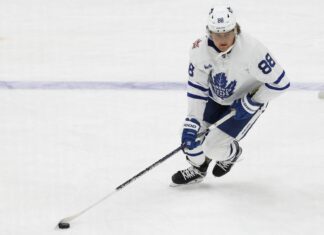The Toronto Marlies recently passed the midway point of the AHL season after winning a pair of games over the Checkers in Charlotte.
With those two wins, the Marlies have topped the Conference halfway through the season, just as they did during their historic season in 2015-16. The Marlies lead the Eastern Conference and — at the time of writing — are just a single point behind the Manitoba Moose for top spot overall in the AHL.
Toronto has dominated North Division opponents, amassing a record of 18-6-0 inside their division, and have had little trouble with Atlantic opponents (10-3-0). Their nemesis so far this year has been their lone Central Division foe in the Manitoba Moose, who were victorious in two games contested at Ricoh Coliseum.
The only team not to suffer an overtime or shootout loss so far this season (perfect 3-0 in games decided after regulation), Toronto’s 28-11-0 record has been built on a stingy defense, excellent penalty kill, and the league’s best road form.
Away from the Ricoh Coliseum, the Marlies have compiled a 17-4-0 record while allowing an average of just 2.05 GAA per game and accumulating a league-high 74 goals for. To put that into some sort of context, Toronto was a .500 team on their travels last season with just 18 wins to their name.
Toronto’s penalty kill is ranked #1 in the AHL at 88.8% (seven percent better than last season) and has tallied six shorthanded markers.
Yet to keep a clean sheet since two shutouts through the opening 10 games of the season, the Marlies have given up just one goal 16 times, giving them a better-than-fighting chance of winning on a nightly basis.
Less stellar has been the Marlies home form (11-7-0 for .611 Pts%), which is ranked just eighth best in the league. A middle of the pack home power play (14.9%) has been inconsistent while allowing five short-handed markers against in the first half.
Their current six-game winning streak is just one shy of their season-high of seven, which tied the club franchise record. Unlike last season’s trials and tribulations early on in the year, the Marlies have put themselves in a superb position at the halfway marker.
Player Grades
A
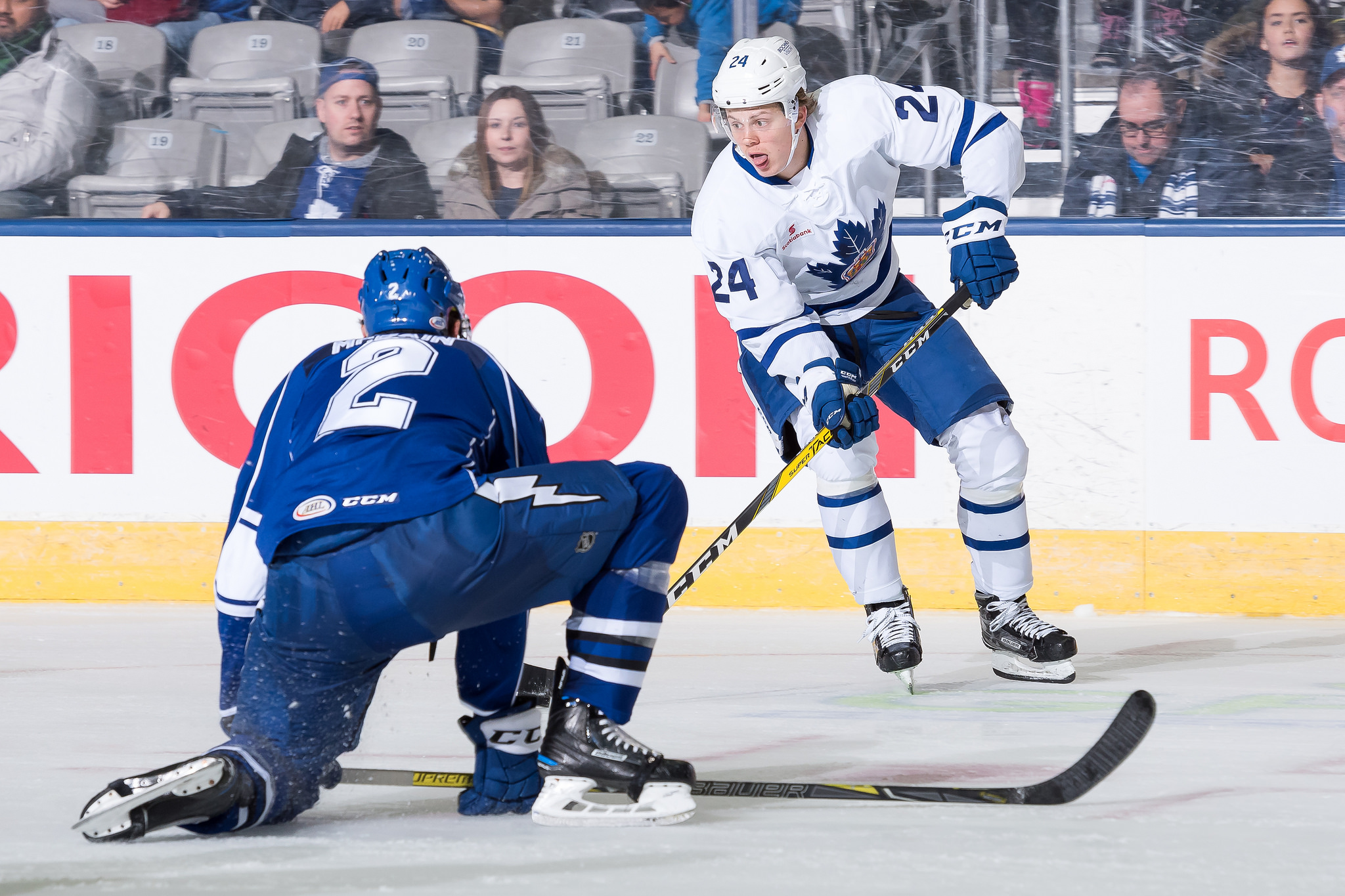
Ben Smith (39GP – 17g – 15a – 32pts)
Recently named Captain, Ben Smith has been one of Toronto’s most consistent performers this season and currently leads the team in goals (17) and points (32). Of his 32 points, 28 have been accrued at even strength and all but two are primary markers. Unlike some of the veterans reassigned by the Maple Leafs last season, Smith’s attitude and commitment to the Marlies cause has been top class.
Kasperi Kapanen (24GP – 12g – 9a – 21pts)
There’s little doubt in my mind that Kasperi Kapanen should be an NHL regular by now, but it’s a credit to him that’s he’s handled his reassignments in exactly the right manner. Sheldon Keefe uses Kapanen on both special teams, and despite only playing 24 games, the 21-year-old is tied for the team lead in power-play goals (5), third in points (9) and has been a key cog on the penalty kill, recently scoring his first shorthanded goal of the season. His 21 points are good for fifth in team scoring and it’s no surprise that Kapanen has been selected as an AHL All-Star.
Garret Sparks (22GP – 15 Wins – 6 Losses – .938 SV%)
Entering his fifth season, there was a degree of pressure on Sparks to deliver after signing a two-year extension in the summer. After suspension and injuries beset his 2016-17 season, the Chicago native has knuckled down and proven himself to be one of the best goaltenders in the AHL. His 15-6-0 record is good for fourth-most wins in the league, with every goaltender ahead of him having received more starts. Sparks’ .938 save percentage is ranked second league-wide. He’s also stopped all four shooters in two shootout victories and recorded two shutouts to boot. The consistency has been superb: Sparks has given up more than two goals only five times this season.
Calvin Pickard (17GP – 12 Wins – 5 Losses – .926 SV%)
Calvin Pickard has been a little overshadowed by the exploits of Garret Sparks, but he’s been no less effective since being acquired by the Leafs. He introduced himself by posting 33 saves on debut against Providence and was the key difference between the two teams in that win. Pickard has given up just one goal in seven of his 16 starts and has one partial shutout from when he played 44 minutes in relief versus Laval in early December. He’s formed the best goaltending tandem in the AHL alongside Sparks, with the pair encouraging and pushing one another in the spirit of a healthy competition. Pickard is on pace to record career highs in wins and save percentage (currently .926) if he and Sparks continue to share the starts.
Travis Dermott (28GP – 2g – 16a – 18pts)
Travis Dermott has undoubtedly been the Marlies’ star man on the blue line this season. My only criticism has been the number of penalties he took early in the year (13 minor penalties in 16 games), but he’s been able to reel that in while continuing to put in excellent performances prior to his callup to the Leafs. Defensively, his gap control is fantastic, he can be physical when called for, and he’s rarely beaten along the boards. His skating ability over all ranges allows him to be confident when pinching into the offensive zone or leading a breakout, and he’s often the first player back covering if the Marlies turn the puck over in a dangerous spot. Dermott’s been a key cog on the PK (the Marlies have struggled during his call-up to Leafs) and he’s also tied for the team lead in assists (16) with Chris Mueller.
B+
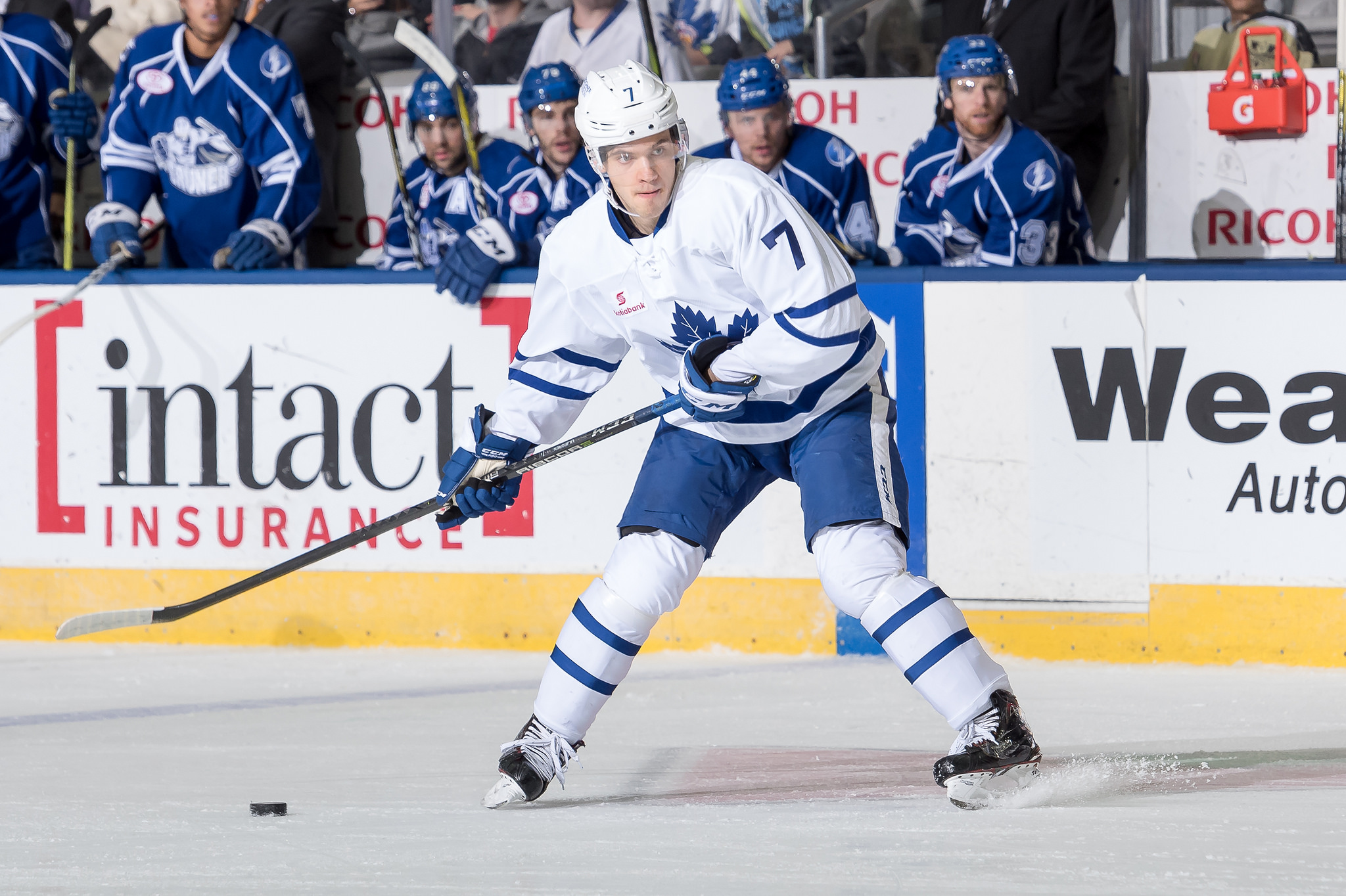
Timothy Liljegren (17GP – 1g – 8a – 9pts)
With Liljegren breaking the league at the tender age of 18 — he won’t turn 19 until late April — it would’ve be easy to forgive a slow start in his first taste of North American hockey. That’s been far from the case for the Swedish defenseman, who has oozed confidence since feeling his way through the first handful of games to begin the year. He’s not been short of confidence with the puck on his stick, venturing on some spectacular forays into opposition territory when the chance arises. Liljegren’s puck-moving ability is as good as advertised, and for the most part, his decision making has been excellent despite his limited professional experience. His lone goal this season came on the power play, where he also has three primary assists, and there is still much more to come offensively from the rookie as the season progresses and his acclimation process continues.
Andreas Johnsson (34 GP – 15g – 11a – 26pts)
I’m sure many would think Johnsson deserves an ‘A’ grade for his play this year, and that’s a fair assumption. However, he’s missed some time for disciplinary reasons. He was suspended by the team earlier in the year for a reason no one outside the organization is privy to. He was then suspended by the league for a hit on Filip Chytil, which was more reckless than malicious but left the Hartford player in a heap along the boards. The Swedish winger has accumulated almost as many PIMs as last year (in half the games played) and taken five minor penalties in his last five outings.
His misdemeanours aside, Johnsson has once again found the net with regularity and encouragingly has been more of a threat at 5v5. Currently second in Marlies overall scoring, 10 of his 15 goals have been accrued at ES (matching last seasons total) while his power play exploits seem him second in team power play points (10). He remains a potent threat from the slot area, a handful when driving from either wing to the net and has the unerring knack of finding himself at the right spot on the ice for second and third opportunities.
Nikita Soshnikov (14GP – 5g – 7a – 12pts)
It’s been something of a season to forget for Nikita Soshnikov, who has just recently been assigned to the Marlies for a conditioning spell. Injuries have again curtailed his involvement this year, but he was nothing short of dynamite during his 14-game AHL stint. His 12 points include four goals and nine points at even strength, two primary power play assists, and a short-handed goal. Like Kapanen, Soshnikov has proven himself above the AHL level and I expect him to dominate again during this upcoming fortnight. The Leafs‘ depth up front presents its challenges for breaking into the big-club lineup, but Soshnikov’s most pressing issue at the moment is staying healthy and in the lineup consistently.
Rinat Valiev (26GP – 1g – 7a – 8pts)
Rinat Valiev is a player who is barely noticeable when playing his best hockey. He’s been a reliable and steady presence on a Marlies blue line comprised largely of defensemen who take more risks on the offensive side of the game. He’s never going to put up a ton of points because he rarely receives power play time and tends to err on the side of caution across the red line. That being said, he owns a decent shot and isn’t totally without the ability as shown by putting up five points in as his last five outings, including his first goal of the season. A good bounce back first half of the season after a rocky sophomore year in 2016-17.
Dmytro Timashov (37GP – 9g – 13a – 22pts)
Dmytro Timashov began the year slowly, with no points through his first five games. However, he’s a better player than the rookie version who suffered from a lack of opportunities last year. He proceeded to put up points in eight of the following nine games (4-6-10). As it stands, he’s ranked fourth in team scoring and second at ES with 17 points to his name, including six goals and eight primary assists. He’s shooting fractionally more (1.75 per game up from 1.69 last year) but it’s still an area of his game that he could work on as he does tend to over-elaborate on occasion. Timashov’s nine goals overall (#3 on Marlies) is just two shy of last season’s goal tally. Having just played his 100th AHL game, the diminutive winger has tallied 46 career points.
Martin Marincin (22GP – 2g – 7a – 9pts)
Marincin has been the consummate professional since his reassignment to the AHL. There’s been little sulking as he’s slotted into the league’s best defense and helped Toronto’s penalty kill remain top of the league. His nine points from the blue line has been a nice boost, including a highlight-reel goal against Binghamton in a game in which he scored twice.
Mason Marchment (19GP – 5g – 7a – 12pts)
Only injury curtailed what was a barnstorming start to the season for Marchment. Nobody from the outside could have foreseen him racking up 12 points already, but through sheer dedication from the rookie and the skills development team, the unsigned winger has made great strides in his development. His five goals include two game winners and he hasn’t been shy about shooting the puck (averaging two shots per game).
B
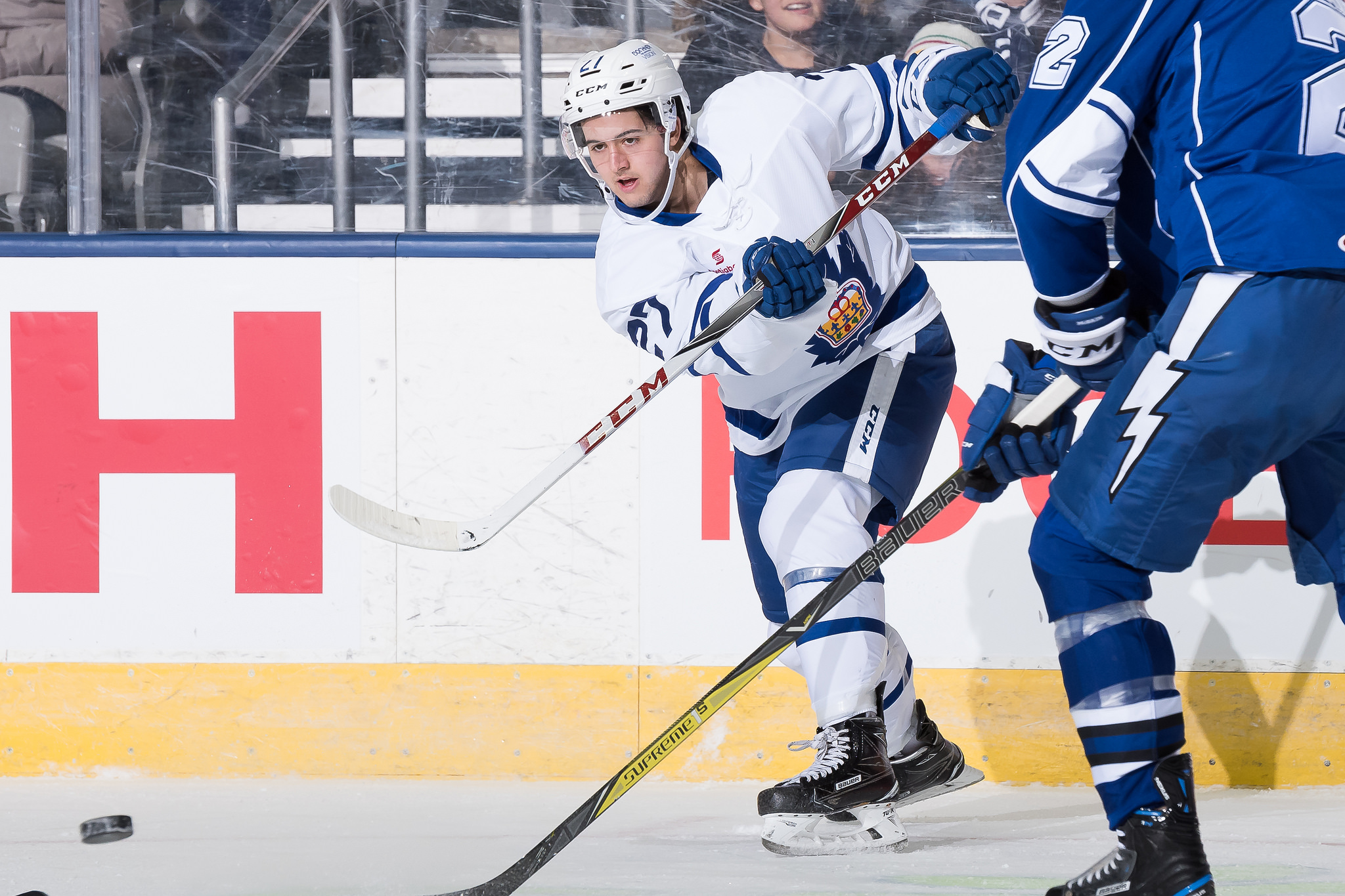
Calle Rosen (32GP – 0g – 9a – 9pts)
Calle Rosen is still finding his feet in North America. He’s undoubtedly talented and has shown some promise, but he’s yet to fully put his game together. He has good tools, but it’s about honing the way he uses them and improving his decision making if he’s going to push on from what’s been a season of ups and downs so far. He owns a wicked shot (averaging 2.34 per game) and has been incredibly unlucky not to find the net – recently having a goal credit changed after his effort glanced the pants of Ben Smith on its way into the net.
Jeremy Bracco (22GP – 3g – 7a – 10pts)
Having battled mono, Bracco was eased into his rookie year by the organization as he adjusts to the physical rigors and 200-foot responsibilities demanded of him at the pro level — a decision which has already reaped some benefits for the team and player. He’s certainly further ahead than fellow rookie Adam Brooks is at this stage and he’s recently been entrusted with extended time on the power play. His edgework is certainly up to scratch at the AHL level, as are his puck skills, and he’s not been short on belief in his ability to make plays of late.
Justin Holl (34GP – 4g – 14a – 18pts)
The roving defenseman is just a single point shy of his points total from last season. He leads defensemen in ES points, adding just two shorthanded points (1-1-2) on special team duties. Even more encouraging is that the right-handed Holl has taken it upon himself to shoot a little more after creating space for himself through his surges down the right wing. He’ll always be prone to a defensive mistake or two because of his offensive tendencies, but he’s managed to rein himself in a little more and find a better balance to his game than last year.
Miro Aaltonen (36GP – 7g – 14a – 21pts)
A hair’s breadth away from making the Leafs at the beginning of the current campaign, Aaltonen has been a steady if unspectacular performer for the Marlies. He’s been entrusted with top line duties, often centering the likes of Kapanen and Johnsson, and has 14 assists as a result. The Finnish forward only has five power play points to his name, but he’s proven himself defensively responsible and adapted well to the rigours of the American League.
Frederik Gauthier (27GP – 5g – 3a – 8pts)
Frederik Gauthier returned from injury way ahead of schedule when making his season debut on October 13. Unsurprisingly, it took him a while to get up to game speed, but the centerman has once again proven himself defensively responsible and added a touch of offense on both sides of special teams. He finished 2017 with the first three-point game of his career, consisting of a pair of goals and a beautiful feed to assist Kapanen.
Vincent LoVerde (32GP – 1g – 5a – 6pts)
The 28 year old defenseman knows the game inside out at the AHL level and has been an ultra dependable performer on the Marlies blue line. His production is down on previous seasons, although his lone goal was a short-handed marker courtesy of a spectacular coast to coast rush.
Rich Clune (22GP – 1g – 1a – 2pts)
Rich Clune’s opportunities may have been limited this season, but he continues to be a positive influence around the club and is one of the leaders in the room and on the ice. His production is never going to be anything to write home about, but he’s been a little unlucky to only record two points this year. A reliable solider on the fourth line, Clune has found some chemistry when paired with one or two of the rookies.
Chris Mueller (39GP – 8g – 16a – 24pts)
The veteran Mueller is a hard player to assess. I expected closer to point per game pace from him, but he got off to a relatively slow start to the season (one point in six games) and the Marlies haven’t exactly been an offensive juggernaut this year. He’s been as advertised for the most part, however, and currently leads the team in power play points (14). Of his eight goals, five are power play tallies and Mueller himself would expect to have a better return than three goals at ES in the second half of the season. He’s proven an excellent set-up man, though, and is tied with Dermott for the team high in assists (16).
Colin Greening (39GP – 8g – 10a – 18pts)
Colin Greening has been one of the nice if now unexpected surprises of the season thus far. After a 2016-17 campaign in which he accumulated just 24 points, Greening has already reached eighteen having been an ever present in the line-up. With 15 of those points primary markers, the veteran forward has not only been a leader in the room but a key contributor on the ice.
B-

Kerby Rychel (39GP – 7g – 12a – 19pts)
Kerby Rychel continues to be an enigma and is fast dropping down the prospect ladder in the Toronto organization. He’s appeared in all 39 games but is just seventh in team scoring with 19 points. Undoubtedly, the Marlies middle of the road power play has played a part in his offensive numbers dropping off somewhat, but Rychel is only eighth on the team in ES points, level with Kapanen (11), who has played far fewer games. The left winger has failed to register a point on 26 occasions this season and has recorded just three points (1-2-3) through his last 13 games.
Adam Brooks (29GP – 3g – 3a – 6pts)
The transition from junior to the professional game is not one that comes easily to every player. An offensive juggernaut the last two seasons in the WHL, the expectation for Brooks was that some of those abilities would translate in his rookie AHL season. In truth, it’s been mostly a struggle for Brooks offensively, but the Winnipeg native has turned a bit of a corner in the last couple of weeks, recording his first goal on New Year’s Eve and adding two more in his next three games. While the production isn’t there yet, Brooks has proven himself reliable on the other side of the puck and been entrusted with penalty killing duties at times.
C
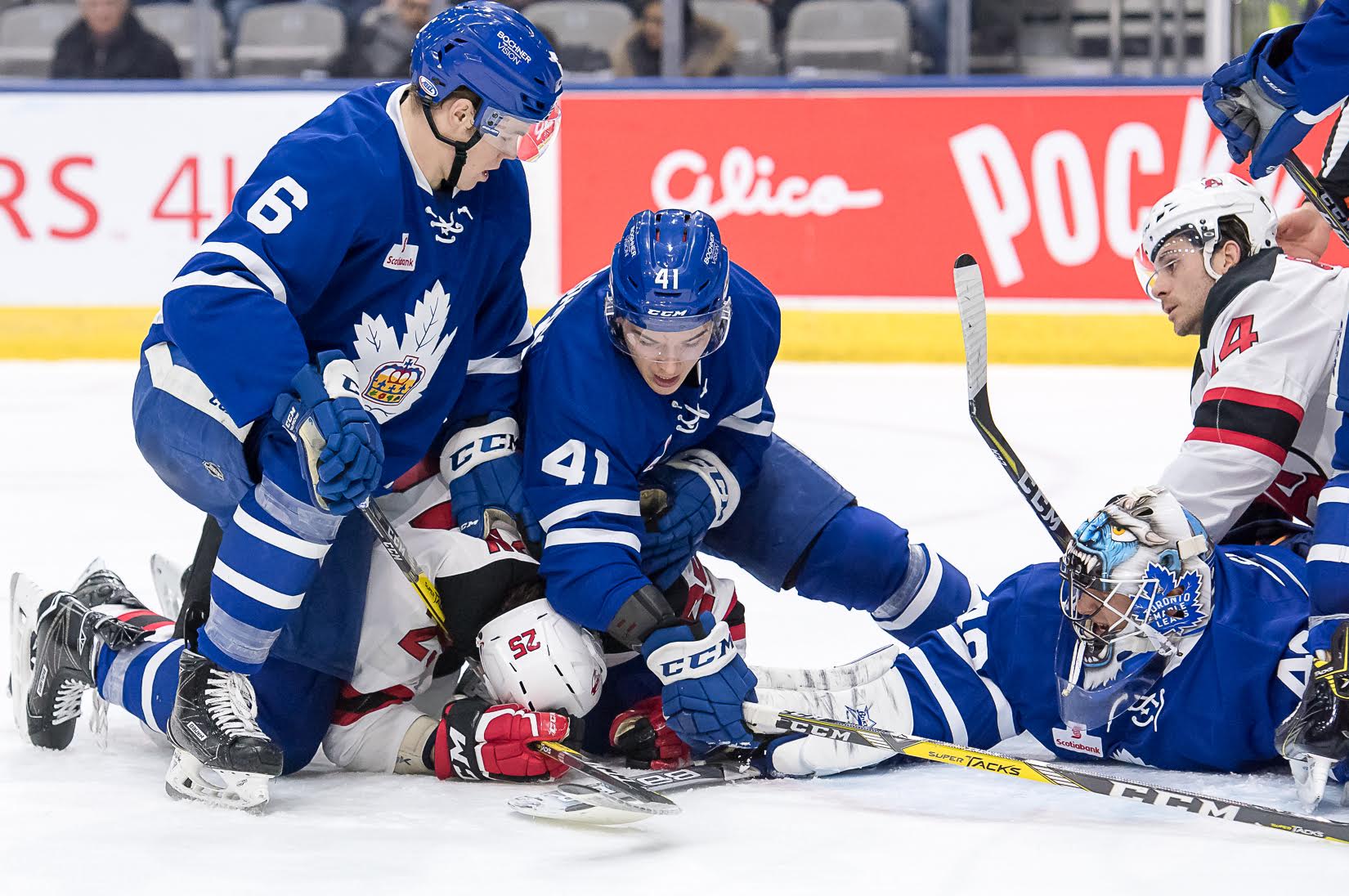
Trevor Moore (36GP – 5g – 3a – 8pts)
Trevor Moore is a curious case this season. Despite a difficult rookie year at times, Moore put up 13 goals and 33 points through 57 games in 2016-17 and the expectation was he would build on that as a sophomore. The California native is a pleasant player to watch with his speed and skill with the puck, but there’s been little in the way of end product with a paltry eight points to show through 36 games.
Andrew Nielsen (35GP – 2g – 9a – 11pts)
Andrew Nielsen is perhaps the biggest disappointment on the Marlies roster at the midway stage. The offense he produced last season was going to be hard to replicate, but just two goals for a player with his shooting ability is a little discouraging. His foot speed remains the issue it was last year, with little signs of improvement in that regard; far too often he’s beaten on the outside by speedier forwards. Perhaps more worrying are his moments of indecisiveness in possession and poor decisions without the puck that often lead to odd-man rushes and quality scoring chances for the opposition.
Ungraded
Jean Dupuy – 7GP, 0-0-0
Sam Jardine – 1GP, 1-0-1
Kasimir Kaskisuo – 1GP, 1-0-0. .963 sv%
Martins Dzierkals – 4GP, 0-0-0
Michael Paliotta – 8GP, 0-0-0, Traded to Texas Stars















![John Gruden after the Leafs prospects’ 4-1 win over Montreal: “[Vyacheslav Peksa] looked really comfortable in the net… We wouldn’t have won without him” John Gruden, head coach of the Toronto Marlies](https://mapleleafshotstove.com/wp-content/uploads/2025/09/gruden-post-game-sep-14-218x150.jpg)








